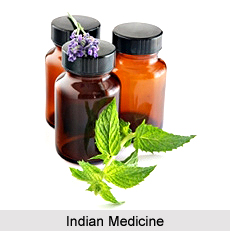 Post Vedic Period commences with the birth of Gautama Buddha in 600 B.C. as a prince in Kapilavastu. The Buddhist period concentrated upon eradication of sufferings and the all round development of medicine. The varied methods of treatment of that period were predominantly based upon the teachings of Atreya, the famous physician of Harappa in the Indus Valley Civilisation.
Post Vedic Period commences with the birth of Gautama Buddha in 600 B.C. as a prince in Kapilavastu. The Buddhist period concentrated upon eradication of sufferings and the all round development of medicine. The varied methods of treatment of that period were predominantly based upon the teachings of Atreya, the famous physician of Harappa in the Indus Valley Civilisation.
Medicines of Post Vedic Period
The Buddhist monks, besides being great social reformers were also accomplished physicians coupled with the zeal and ardour to attend to the masses and render a supporting hand to the sick and ailing members of the society. Lord Buddha was himself a great physician, possessing in-depth knowledge about medicine. The Buddhist monks when suffered from seasonal diseases were prescribed to take four types of medicines, Kalika, Yamika, Saptahika and Yavajjivika. In the Buddhist pharmacopoeia, the kalikas were the pulp of boiled rice or any other grain known as Manda, porridge or boiled rice called Oddna, sour gruel or kulmasa, meat or mamsa and cakes prepared from flour or opupa.
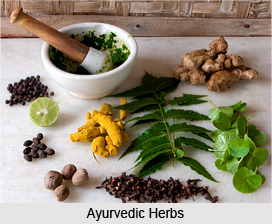 The Yamikas were 8 types of drinks, such as Cocapanam, prepared from cinnamon bark; Mocapdnam amde of plantain trees, i.e. Musa sapientum; Kolapanam a drink prepared from Jujube tree; Asvatthapanam a drink prepared from the fig tree; Udumburapanam, made from berries; Mrdvikapdnam, prepared from grapes and Kharjurapdnam, prepared from dates. The Saptdhikas used by the Buddhists were: taila or oil; sarpi or ghee; phanita, juice of sugarcane; madhu or honey; sarkara or dry sugar. The Yavajjivika were mulabhaisajya or root medicine; ganda bhaisyajya or tubers; patrabhaisajya or leaf medicine; puspabhaisajya or flower medicine; 5 jatus or lac like silajatu; 5 ksaras like alkalis; 5 lavanas or salts and 5 kasdyas or astringents like haritaki. Among the Mulabhaisajyas there are Vaca-Acorus Calamus; Musta-Cyperus Rotundus; Haridrd-Curcuma longs; Attvisa-Aconitum heterophyllum; Arka-Calotropis gigantea.
The Yamikas were 8 types of drinks, such as Cocapanam, prepared from cinnamon bark; Mocapdnam amde of plantain trees, i.e. Musa sapientum; Kolapanam a drink prepared from Jujube tree; Asvatthapanam a drink prepared from the fig tree; Udumburapanam, made from berries; Mrdvikapdnam, prepared from grapes and Kharjurapdnam, prepared from dates. The Saptdhikas used by the Buddhists were: taila or oil; sarpi or ghee; phanita, juice of sugarcane; madhu or honey; sarkara or dry sugar. The Yavajjivika were mulabhaisajya or root medicine; ganda bhaisyajya or tubers; patrabhaisajya or leaf medicine; puspabhaisajya or flower medicine; 5 jatus or lac like silajatu; 5 ksaras like alkalis; 5 lavanas or salts and 5 kasdyas or astringents like haritaki. Among the Mulabhaisajyas there are Vaca-Acorus Calamus; Musta-Cyperus Rotundus; Haridrd-Curcuma longs; Attvisa-Aconitum heterophyllum; Arka-Calotropis gigantea.
The Gandabhaisajyas used by the Buddhist monks were: Chandana, Chavika-Piper retro-fractum; Padmaka-Prunus Cerasoides; Devaddru-Cedrus Deodar; Guduci-Tinospora Cordifolia and Ddruharidra-Berberis Aristata.
The monks also used Patrabhaisajyas as their medicines for curing diseases. These were the leaves of Patola-Trichosanthes dioca; Vdsikd-Genddrussa vulgaris; Nimba-Azddirachta indicd; Kosataki-Luffa acutangula; and Saptaparna-alstonia scholaris.
The Puspabhaisajyas were the flower of Nimba (vide ante); flower or Dhatuki-Woodfordia floribunda; flower or Sati-Hedychium spicatum; and the filament or kesara of Padma-Nelumbo nucifera. The five Jatus are: Hingu or Ferula foetida; Sarjarasa or the exudation of Valeria indica.
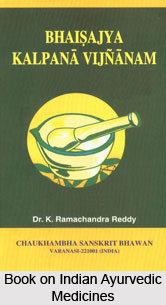
Besides these, there are five ksaras, five salts and five kasayas that were used during the post Vedic period.
The five ksaras are: Yavaksara- it is the alkali made from the remains of burnt green barley corns known as hordeum vulgare; Yavasukaksara also known as alkali are made of the ashes of burnt barley straw; Sarjiksara or impure alkali; Tilaksara or the alkali made from sesamum indicum and Vasakaksara is the alkali prepared from gendarussa vulgaris.
The five salts are: Saindhava-amonium chloride; Sauvarcala, the salt made by boiling soda with emblic myrobalan; Romaka, the salt derived from saline earth; and Samudraka, the salt extracted from sea water.
The five kasayas used during the post vedic period are: Amrakasaya, the astringent or mangtfera indica, Nimbakasdya, the astringent of Azadirachta indica; Jambukasaya, the astringent prepared from rose apple tree, i.e. Syzygium cumini; Sirisakasaya-Acacia sirissa; and Kosambakasaya.
Physicians of Post Vedic Period
The Post Vedic period marked the emergence of an assemblage of expert physicians blessed with profound pharmacological knowledge, rendering unremitting service to the ailing patients with impeccable results. Some of the noteworthy physicians to have served the society during that period are named below:
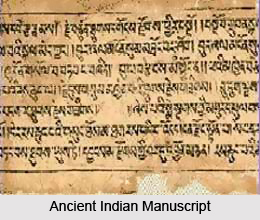 Jivaka Jivaka, regarded as one of the eminent physicians of the post Vedic period was a follower and close associate of Lord Buddha. King Bimbisara recovered him from a garbage dump and reared as his own son. He was educated in the medical school of Taxila under the guidance of Atreya. The son of Bimbisara, Ajatasatru was converted into Buddhism by Jivika. He authored the book Brdhqjivakatantra.
Jivaka Jivaka, regarded as one of the eminent physicians of the post Vedic period was a follower and close associate of Lord Buddha. King Bimbisara recovered him from a garbage dump and reared as his own son. He was educated in the medical school of Taxila under the guidance of Atreya. The son of Bimbisara, Ajatasatru was converted into Buddhism by Jivika. He authored the book Brdhqjivakatantra.
Acharya Bhagabhata
Acharya Bhagabhata is known to have re-edited Charaka Samhita and later named it as `Astanga Ayurveda.`
Bagabhata
Bagabhata, another scholar of the same name, taught in Nalanda. He has authored the renowned medical text `Rasaratnasamucchya.`
Madhaba Kara
Madhaba Kara, a native of Bengal was a notable physician of the post Vedic period. He composed a book Madhaba Niddna that was later translated into Persian during the reign of the Abbasid Khalifa Haroon-al-Rashid of Baghdad. He wrote another book, named Ratnamdla that deals with studies on the materials of medicine.
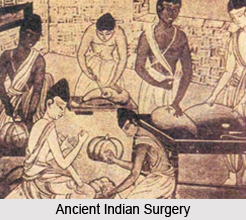 Chakrapani Dutta
Chakrapani Dutta
A famous Bengali author of medical texts, Chakrapani Dutta was born in a village, Mayureswara in the Barendrabhumi (North Bengal) into a learned family of Lodhrabati. Chikitsd Samgraha or Chakradatta is a priceless reference book authored by him. Bhanu Dutta, his brother was also a physician and pathologist. Chakrapani had written two other books, Dravyaguna and Sarvasdra Samagraha. He had edited the diagnostic methods of Madhaba Kara, named as Chakradatta pradeepikd. Chakrapani Dutta had conferred upon him the honorary titles of Charaka Chaturandma and Susruta Sahasrandma for his work.
The dawn of the 12th century witnessed the frequent attacks of the Muslim invaders that resulted in a state of pandemonium. The scientific and literary pursuits were in complete abeyance. Thus, the sporadic attacks and the chaos state of affairs led to the rapid decline in the practice and research in medicine including ayurveda.




















